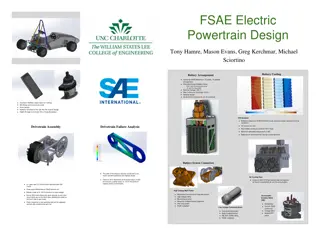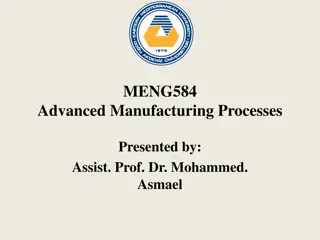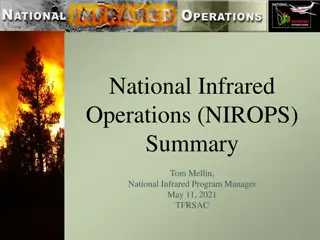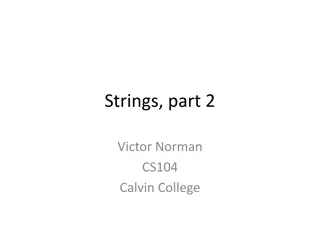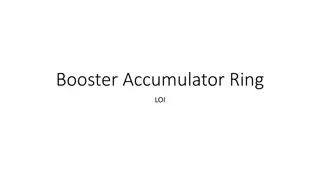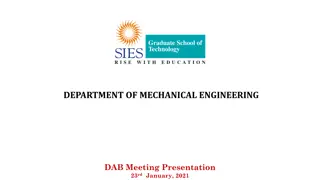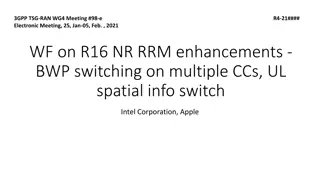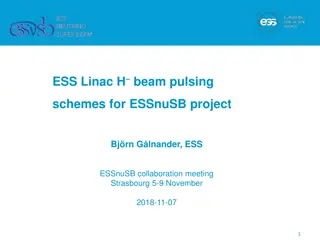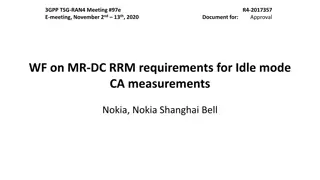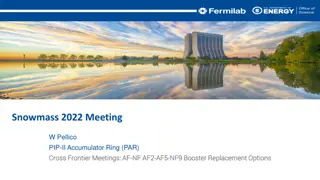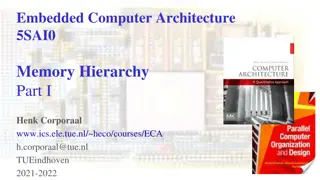ESSnuSB Emmittance Accumulator Meeting Summary
Meeting held on 7/11/2018 to discuss fixing emittances for the Emmittance.ESSnuSB.Accumulator. Various specifications and requirements were considered, including beam properties, target specifications, and beam distribution. Injection methods and pulsing structures for the Linac were also discussed, with a focus on optimizing efficiency and meeting target criteria.
Uploaded on Sep 12, 2024 | 0 Views
Download Presentation

Please find below an Image/Link to download the presentation.
The content on the website is provided AS IS for your information and personal use only. It may not be sold, licensed, or shared on other websites without obtaining consent from the author.If you encounter any issues during the download, it is possible that the publisher has removed the file from their server.
You are allowed to download the files provided on this website for personal or commercial use, subject to the condition that they are used lawfully. All files are the property of their respective owners.
The content on the website is provided AS IS for your information and personal use only. It may not be sold, licensed, or shared on other websites without obtaining consent from the author.
E N D
Presentation Transcript
Emmittance ESSnuSB Accumulator Meeting 7/11 2018 WG3 Elena Wildner
Some preliminaries The goal of the meeting was to fix emittances The emittance depends on the number of particles in the linac beam pulse and the energy, 2.86 ms, 62.5 mA, 2 GeV (conservatively) Chopping of the Linac beam 10-15% loss and other losses The linac beam can be as long as 2.9 ms including cavity filling time. Deducting the filling time, the available pulse for the accumulation is being discussed Chopping of the linac beam is needed for the beam extraction gap Assume extraction gap 10 % Take into account longitudinal beam leaking into gap rf will be needed This gives part of the requirements on the extraction kicker
After extraction The beamline requirements have been decided WP4? Can it be relaxed? The beam properties on/inside the target need to be specified as well and particle distribution in the beam result from injection painting, space charge and beam dynamics The divergence on the target should be zero (momentum and steering tolerances) SNS has specifications on the target of divergence and particle distribution Question to WP4 what are the requirements we have for the ESSnuSB target ?
Injection The initial beam distribution is painted at injection Define the wanted distribution and the emittance critera The baseline is now laser stripping, one ring (see next slide) Lattice will be adapted to the laser stripping injection system The fallback is to use foil, one ring 56 Hz or 4 rings 28 Hz This case also needs gaps (100 sec) for distribution into the different rings Several stacked rings One ring One ring
We can inject 4 batches! Maybe even more if needed (if the target can accept them, WP2) Our baseline pulsing structure 71.4 ms 14 Hz for ?target P H- H- P 2.86 ms 2.86 ms 3.16 ms 3.16 ms 100 ?s 0.715 ms 1 pulse with 3 gaps for 4 fillings Gap for distributors and painting bumps 100 ns 1.25 ?s ~ 530 bunches for 1 filling
Pulsing structure of the Linac & new baseline S Several stacked rings: expensive and operationally demanding everal stacked rings: expensive and operationally demanding S Several batches in one ring everal batches in one ring Pulsing of Pulsing of linac linac several times more often to fill accumulator sequentially several times more often to fill accumulator sequentially Demanding on Demanding on linac linac equipment: cavities, couplers etc. equipment: cavities, couplers etc. Demanding on target/horn powering Demanding on target/horn powering Gives higher temperatures on injection foil (needs time to cool between Gives higher temperatures on injection foil (needs time to cool between linac 1 batch in one ring with 4 (baseline) 100 1 batch in one ring with 4 (baseline) 100 ?s gaps ( Demanding on target/horn powering? Now confirmed ok!! Can we do > 4 batches for one Demanding on target/horn powering? Now confirmed ok!! Can we do > 4 batches for one linac Switching elements in the extraction line: 100 Switching elements in the extraction line: 100 ?s available time Too high temperatures on injection foil (may need laser stripping technology, long lead times, lossy?) Too high temperatures on injection foil (may need laser stripping technology, long lead times, lossy?) linac batches), seems feasible batches), seems feasible pulsing meeting July, 2018) ) s gaps (M. M. Eshraqi Eshraqi, , linac linac pulsing meeting July, 2018 linac pulse? pulse? 1 Ring 1B L 1 Ring 3B F 3 Ring 1B F 1 Ring 1B P 3 Ring 3B P E. Wildner Number of rings 1 1 3 1 3 Linac beam batches 1 3 1 1 3 Linac Pulsing [Hz] 28 56 28 28 56 B: Batches L: Laser stripping F: Foil stripping P: Proton injection Pulse length [ms] > 2.86 > 2.86/3 > 2.86 > 2.86 > 2.86/3 Extr. chopping [ns] Inj. chopping [ s] 100 100 100 100 100 100 na >100 100 na Inj. stripping laser foil foil na na 6 Our baseline
Strategy for emittance specifications Emittance values for Accumulator set at RAL-meeting Jan 2017 Beam Line to target taken into account (question: can it be enlarged ?) Adopted extraction beam line value@3 sigma (99 %), Gaussian, 75 Pi mm mrad unnormalized, Later 120 Pi proposed PyOrbit gives the emittance and distribution of the beam at the end of the injection Continue simulation 1000 turns to see beam evolution to check delayed extraction Is injection and extraction equipment adapted to 75 Pi mm mrad? Check if compatible with collimation
Summary, meeting at RAL, Jan 2017 Summary by S. Machida = 2.967 for 2 GeV
Collimator acceptance estimation, slide from Ye Zou SNS ESSnuSB75 ESSnuSB100 Correlated Anti-correlated Correlated Anti-correlated Correlated Anti-correlated ? 120 160 75 75 100 100 ?1 ?2 140 180 95 95 120 120 280 200 190 115 240 140 Coll. Emitt. 300 200 260 ? ?1primary collimator emittance ?2secondary collimator emittance Unit: mm mrad beam geometric (unnormalized) emittance ?2> 2?1> 2? Correlated painting ?2> ?1> ? Anti-correlated painting N. Catalan-Lasheras 16/08/18 ESSnuSB Accumulator, NUFACT18 Blacksburg, Y. Zou 9
Percent or sigma ? Simulations give the distributions we can get Suggestions that we work with % Beam loss 1 W/m in ring At Megawatt levels, for a storage ring of several hundred m this means 10 -6 fractional loss per m, tolerable beam loss is 10 -4 . SNS: acceptance of collimation system 300 Pi mm mrad Y. Zou proposes for ESSnuSB 260 Pi mm mrad for collimation Calculations will also be performed with 120 Pi mm mrad, primary collimator (100%)
Injection Injection Linac beam, 100 s chopping, 0.35 Pi mm mrad normalized 1 sigma Brennan Goddard, from email: Should be possible to generate the new waveforms with one modified generator chassis. It may also be possible to use three generator chassis in parallel with an additional decoupling circuit. Simple series diodes would probably not be enough. For pulse 2 and 3 there is already beam in the machine which means they have to be well synchronized: rise, flat top and fall. The existing design is not made for well synchronized current rise. Modification of design is required, but feasible. Flat top and current fall are not a problem. Rack space would be increased by factor of 3 from 4 to 12 racks for the 3 magnets. Feasibility overall: OK. Complexity depends on precision and rise, fall time. Check this for 4 batches!!! (comment E. Wildner)
Extraction Extraction The BT Group would need beam sizes and rise/fall times to estimate the extraction system technology and design. This need to be calculated from the evolution of the beam in the ring and/or collimation (also momentum ?). Once the kicker systems have been designed, estimation of impedance values for beam dynamics can be estimated without too much effort from previous calculations. The extraction kicker impedance is the most important contribution to the machine impedance and is needed for calculations of beam stability. 10 % of ~ 1.3 s (one turn) ~ 130 ns to prepare extraction conditions. To be able to optimize these timing conditions by for example make a larger ring, we need to check with HOM calculations in the linac. B. G lnander can give some margin for this according to his calculations? The timing conditions may influence the kicker apertures (beam size, emittance) and consequently the kicker design and feasibility.
Emittances (99% un-normalized) different painting options Summary H. Sch nauer Foil stripping (56Hz pulsing only): 75 Space-charge tune shifts ~-0.13, max. foil temperatures < 1800K Correlated painting only -> square beam Liouville Injection of Protons: MISHIF (Injection optimization code by C. Prior) : So far only exploratory tests done by Ye Zou (see next slide): 225 (no space-charge), >250 (with space charge;) Correlated painting only -> square beam MISHIF for H- foil stripping: Hope to produce less foil passes Further MiSHIF studies needed to explore the limits of both applications Correlated painting only -> square beam Laser stripping: Should be determined by acceptable space-charge tune shifts: <75 ; anti-correlated painting possible -> circular beams
, Courtesy Ye Zou Tolerable fractional beam loss is 10 -4 The effect of space-charge is from a very simple model. Can PyORBIT be used with MISHIF? But possibly the application to H- injection could allow more particles/pulse (Dixit H. Sch nauer)
Lattice status Use foil stripping lattice (lattice from Horst giving no oscillations) Permits continuing started work Will serve for the 56 Hz option ( fall back ) Revise injection painting optimization Check resulting distribution, 100% KV option (with 10^-4 losses by scraping) Envisage laser stripping optics and painting after foil stripping case gives results
Summary What distribution (at extraction ?) are we aiming for using painting and what is the best we can get? Adopt 75 Pi mm mrad 99% unnormalized for simulations ? Do we take 120 Pi 100%? Our final result to the equipment team.
Relations, reminder = 2.967 for 2 GeV




